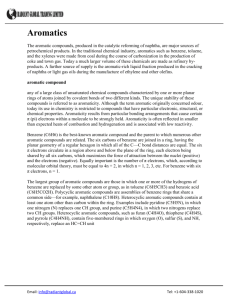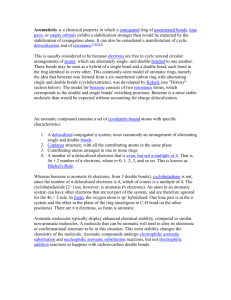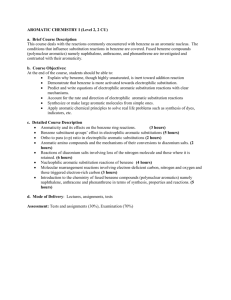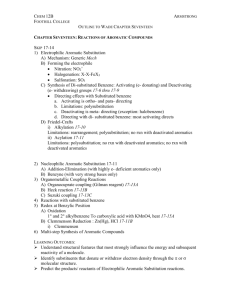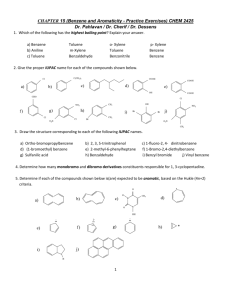Aromatic Compounds
advertisement
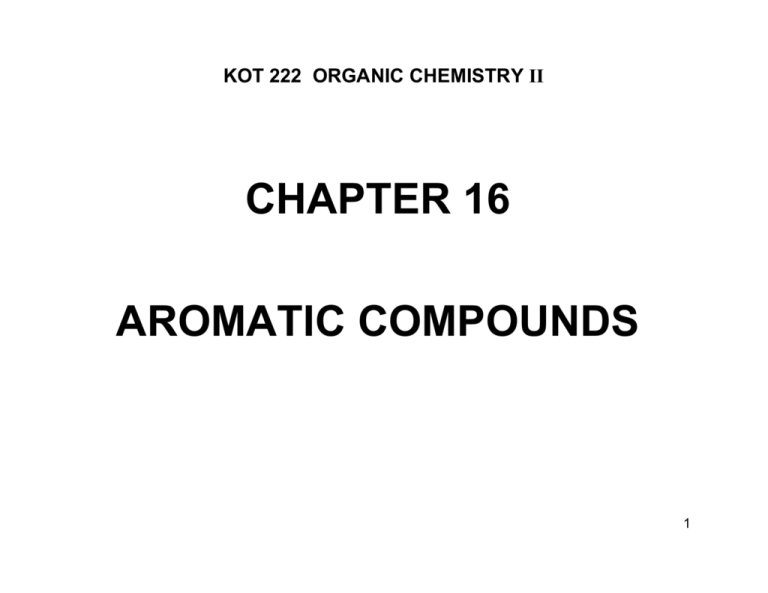
KOT 222 ORGANIC CHEMISTRY II CHAPTER 16 AROMATIC COMPOUNDS 1 Benzene ¾ An aromatic compound. ¾ Isolated in 1825 by Michael Faraday who determined C:H ratio to be 1:1. ¾ Synthesized in 1834 by Eilhard Mitscherlich who determined molecular formula to be C6H6. ¾ Other related compounds with low C:H ratios had a pleasant smell, so they were classified as aromatic. 2 Kekulé Structure of Benzene ¾ Proposed in 1866 by Friedrich Kekulé, shortly after multiple bonds were suggested. ¾ Showing localized double-bonds. ¾ Failed to explain existence of only one isomer of 1,2-dichlorobenzene. Cl Cl X Cl Cl 3 Resonance Structure of Benzene ¾ Benzene is actually a resonance hybrid between the two Kekulé structures. ¾ The pi electrons are delocalized, with a bond order of 1.5 between adjacent carbon atoms 4 Orbital Representation of Benzene ¾ Benzene is a flat ring of sp2 hybrid carbon atoms with their unhybridized p orbitals all aligned and overlapping. ¾ The conjugation and delocalization of the electrons give greater stability. 5 Unusual Reactions of Benzene ¾ Benzene as a cyclic conjugated triene is predicted to react as polyenes. ¾ But, its reactions are unusual. Alkene + KMnO4 → diol (addition) Benzene + KMnO4 → no reaction. Alkene + Br2/CCl4 → dibromide (addition) Benzene + Br2/CCl4 → no reaction. With FeCl3 catalyst, Br2 reacts with benzene to form bromobenzene + HBr (substitution!). Double bonds remain. 6 Unusual Stabilities of Benzene ¾ The hydrogenation of the first double bond of benzene is endothermic. 7 Annulenes ¾ Cyclic hydrocarbons with alternating single and double bonds (uncharged, even no. of C atoms). Assumptions: All are aromatic. Have similar stabilities as benzene. ¾ But, not all are aromatic. 8 The MOs of Benzene ¾ Six overlapping p atomic orbitals form six MOs. ¾ Three will be bonding, three antibonding. ¾ The intermediate energy levels are degenerate, two MOs at each level. ¾ Lowest energy MO will have all bonding interactions, no nodes. ¾ As energy of MO increases, the number of nodes increases. 9 10 11 Energy Diagram for Benzene ¾ The six electrons fill three bonding pi orbitals. ¾ All bonding orbitals are filled (“closed shell”), an extremely stable arrangement. 12 The MOs of Cyclobutadiene ¾ There are four MOs: the lowest-energy bonding orbital, the highest-energy antibonding orbital, and two degenerate nonbonding orbitals. 13 Energy Diagram for Cyclobutadiene ¾ Four pi electrons fill the MOs. ¾ Following Hund’s rule, two electrons are in separate degenerate orbitals. ¾ This diradical with the highest-lying electrons in nonbonding MOs would be very reactive. 14 Polygon Rule ¾ The energy diagram for an annulene has the same polygonal shape as the cyclic compound with one vertex (all-bonding MO) at the bottom. ¾ The nonbonding line cuts horizontally through the center of the polygon. ¾ The pi electrons fill the MOs follows the aufbau principle and Hund’s rule. 15 Aromatic Requirements 1. Structure must be cyclic with conjugated pi bonds. 2. Each atom in the ring must have an unhybridized p orbital. 3. The unhybridized p orbitals must overlap to form a continuous ring. (Usually planar structure.) 4. Delocalization of pi electrons over the ring must lower the electronic energy 16 Anti- and Nonaromatic ¾ Antiaromatic compounds are cyclic, conjugated, with overlapping p orbitals around the ring, but the energy of the compound is greater than its open-chain counterpart. antiaromatic ¾ Nonaromatic compounds do not have a continuous ring of overlapping p orbitals and may be nonplanar. CH3 CH3 17 Hückel’s Rule ¾ If the compound has a planar and continuous ring of overlapping p orbitals and has 4N + 2 electrons, it is aromatic. ¾ If the compound has a planar and continuous ring of overlapping p orbitals and has 4N electrons, it is antiaromatic. ¾ Otherwise, the system/compound is nonaromatic. 18 Benzene Six pi electrons. (4N+2) system Aromatic Cyclobutadiene Four pi electrons. (4N) system Antiromatic Cyclooctatetraene (4N) system X Antiromatic √ Nonaromatic 19 Larger Annulenes ¾ Larger 4N annulenes are not antiaromatic because they are flexible enough to become nonplanar. [12] annulene [16] annulene ¾ Larger 4N+2 annulenes depend on whether the molecule can adopt the necessary planar conformation. H H All-cis nonaromatic Two trans nonaromatic naphthalene aromatic 20 MO Derivation of Hückel’s Rule ¾ In a cyclic conjugated system, the lowest-energy MO is filled with two electrons. ¾ Each of the additional shells has two degenerate MOs, with space for four electrons. A diradical, unstable. 21 Aromatic Ions ¾ Hückel’s rule also applies to systems having odd numbers of C atoms and bearing positive or negative charges. Cyclopentadienyl Ions: ¾ The cation has an empty p orbital, 4 electrons, so antiaromatic. ¾ The anion has a nonbonding pair of electrons in a p orbital, 6 e-’s, aromatic. 22 Acidity of Cyclopentadiene ¾ Unusually acidic (pKa of 16). ¾ Loss of a proton converts the nonaromatic diene to the aromatic cyclopentadienyl anion. 23 Cyclopentadienyl cation ¾ Huckel’s rule predicts that the cyclopentadienyl cation, with four pi electrons, is antiaromatic. ¾ The cyclopentadienyl cation is not easily formed. 24 Cycloheptatrienyl Ions ¾ The cycloheptatrienyl cation (tropylium ion) is easily formed. H H OH + H , H2O + 6 pi electron, (4N+2) system, aromatic ¾ The cycloheptatrienyl anion is difficult to form. H H H B 8 pi electron, 4N system, antiaromatic 25 Cyclooctatetraene Dianion ¾ Cyclooctatetraene is nonaromatic. ¾ Its dianion is easily prepared with planar, regular octagonal structure – aromatic. Continuous overlapping p orbitals. (4N+2) system. 26 Heterocyclic Aromatic Compounds A heterocyclic compound is a cyclic compound in which one or more of the ring atoms is an atom other than carbon 27 Pyridine ¾ Aromatic nitrogen analogue of benzene. ¾ It has six delocalized electrons in its pi system. ¾ The two non-bonding electrons on nitrogen are in an sp2 orbital, and they do not interact with the pi electrons of the ring. These electrons are in the sp2 orbital perpendicular to 28 the p orbital. Protonation of pyridine: ¾ Pyridine is basic, with non-bonding electrons available to abstract a proton. aromatic aromatic 29 Pyrrole ¾ An aromatic five-membered heterocycle. ¾ Nonbonding electrons on N atom involve in the pi bonding system, so much weaker base. No unhybridized p orbital needed for aromaticity 30 Basic or Nonbasic? ¾ N atom with it nonbonding electrons involve in the pi bonding system is nonbasic. N N Pyrimidine has two basic nitrogens. N N H Imidazole has one basic nitrogen and one nonbasic. N N H N N Purine? 3 basic, 1 nonbasic Most nonbasic nitrogens have three single bonds. Most basic nitrogens have a double bond in 31 the ring. Other Heterocyclics ¾ All are aromatic 32 Polynuclear Aromatic Hydrocarbons ¾ Compounds composed of two or more fused benzene rings. Naphthalene Anthracene Phenanthrene 33 Reactivity of Polynuclear Hydrocarbons ¾ As the number of aromatic rings increases, the resonance energy per ring decreases. ¾ These large PAHs can undergo addition reactions. 6 7 5 8 H Br 9 1 4 7 2 6 3 5 H 10 Br 4 8 3 9 Br 2 10 1 H H Br (mixture of cis and trans isomers) 34 Larger Polynuclear Aromatic Hydrocarbons ¾ Formed in combustion (tobacco smoke). ¾ Many are carcinogenic. ¾ Epoxides form, combine with DNA base. pyrene 35 Allotropes of Carbon ¾ Amorphous: small particles of graphite; charcoal, soot, coal, carbon black. ¾ Diamond: a lattice of tetrahedral C’s. ¾ Graphite: layers of fused aromatic rings. 36 Some New Allotropes of Carbon ¾ Fullerenes: 5- and 6-membered rings arranged to form a “soccer ball” structure. ¾ Nanotubes: half of a C60 sphere fused to a cylinder of fused aromatic rings. 37 Fused Heterocyclic Compounds Common in nature, synthesized for drugs. 38 Common Names of Benzene Derivatives OH CH3 phenol toluene H C styrene CH2 OCH3 NH2 aniline anisole O O O C C C acetophenone CH3 benzaldehyde H OH benzoic acid 39 Disubstituted Benzenes The prefixes ortho-, meta-, and para- are commonly used for the 1,2-, 1,3-, and 1,4- positions, respectively. 40 3 or More Substituents Use the smallest possible numbers, but the carbon with a functional group that define the base name is #1. OH O 2N NO 2 NO 2 1,3,5-trinitrobenzene O2N NO2 NO2 2,4,6-trinitrophenol 41 Common Names for Substituted Benzenes CH3 CH3 O OH C OH CH3 CH3 m-xylene H3C CH3 mesitylene o-toluic acid H3C p-cresol 42 Phenyl and Benzyl ¾ Benzene ring as a substituent on another molecule is called as phenyl group. CH2 C C CH3 Br Ph CH 2 C C CH 3 1-phenyl-2-butyne phenyl bromide ¾ Benzyl group: seven-carbon unit consisting of a benzene ring and a methylene group. 43 Physical Properties of Benzene and Its Derivatives ¾Melting points: More symmetrical than corresponding alkane, pack better into crystals, so higher melting points. ¾Boiling points: Dependent on dipole moment, so ortho > meta > para, for disubstituted benzenes. ¾Density: More dense than nonaromatics, less dense than water. ¾Solubility: Generally insoluble in water. 44 IR and NMR Spectroscopy ¾C=C stretch absorption at 1600 cm-1. ¾sp2 C-H stretch just above 3000 cm-1. ¾ 1H NMR at δ7-δ8 for H’s on aromatic ring. ¾ 13C NMR at δ120-δ150, similar to alkene carbons. 45 Mass Spectrometry ¾ The most common fragmentation of alkylbenzene derivative is the cleavage of a benzylic bond. 46 UV Spectroscopy ¾ Benzene has three absorptions. λmax at 184 nm Additional conjugated double bond cause bathochromic shift. Moderate band Characteristic band 47 48




